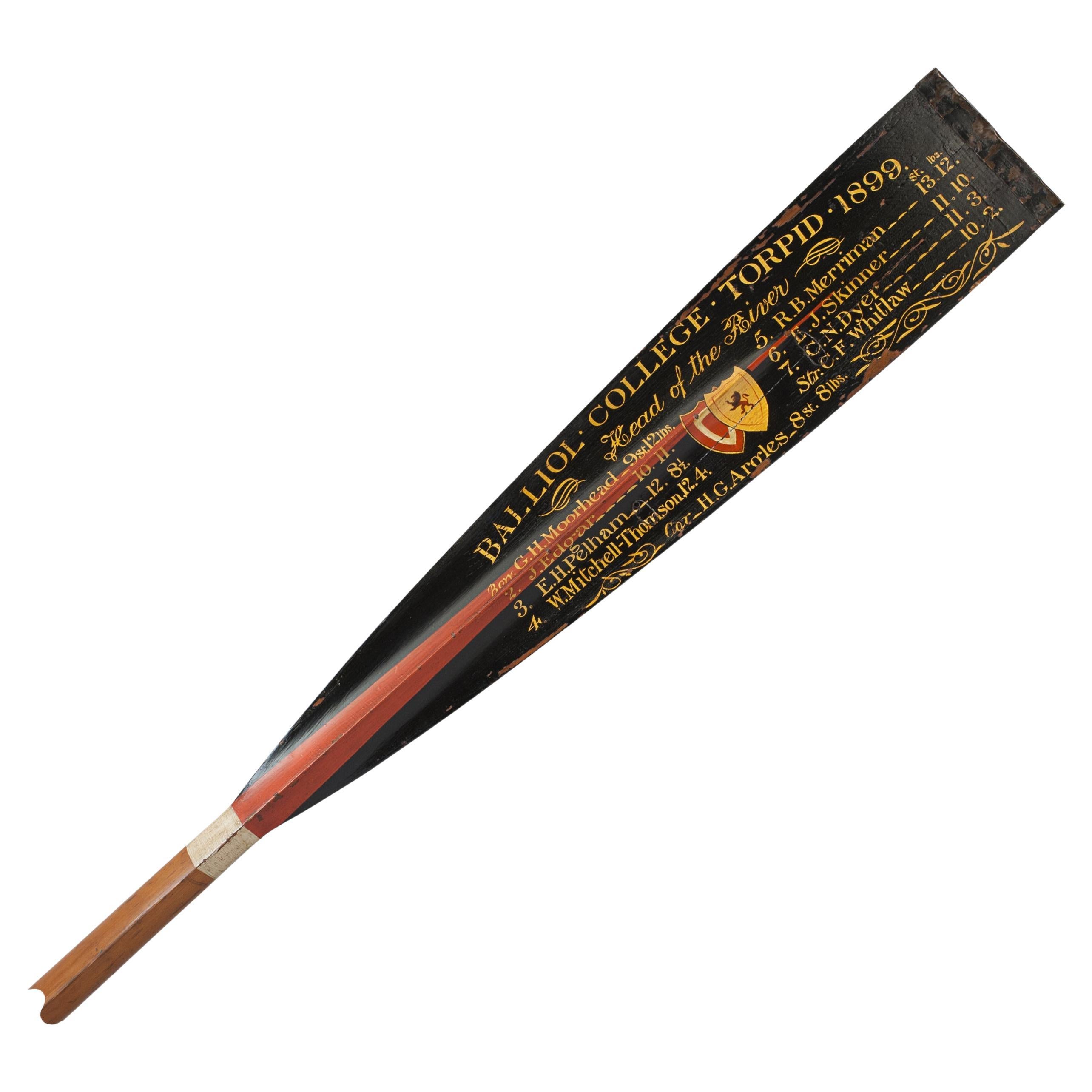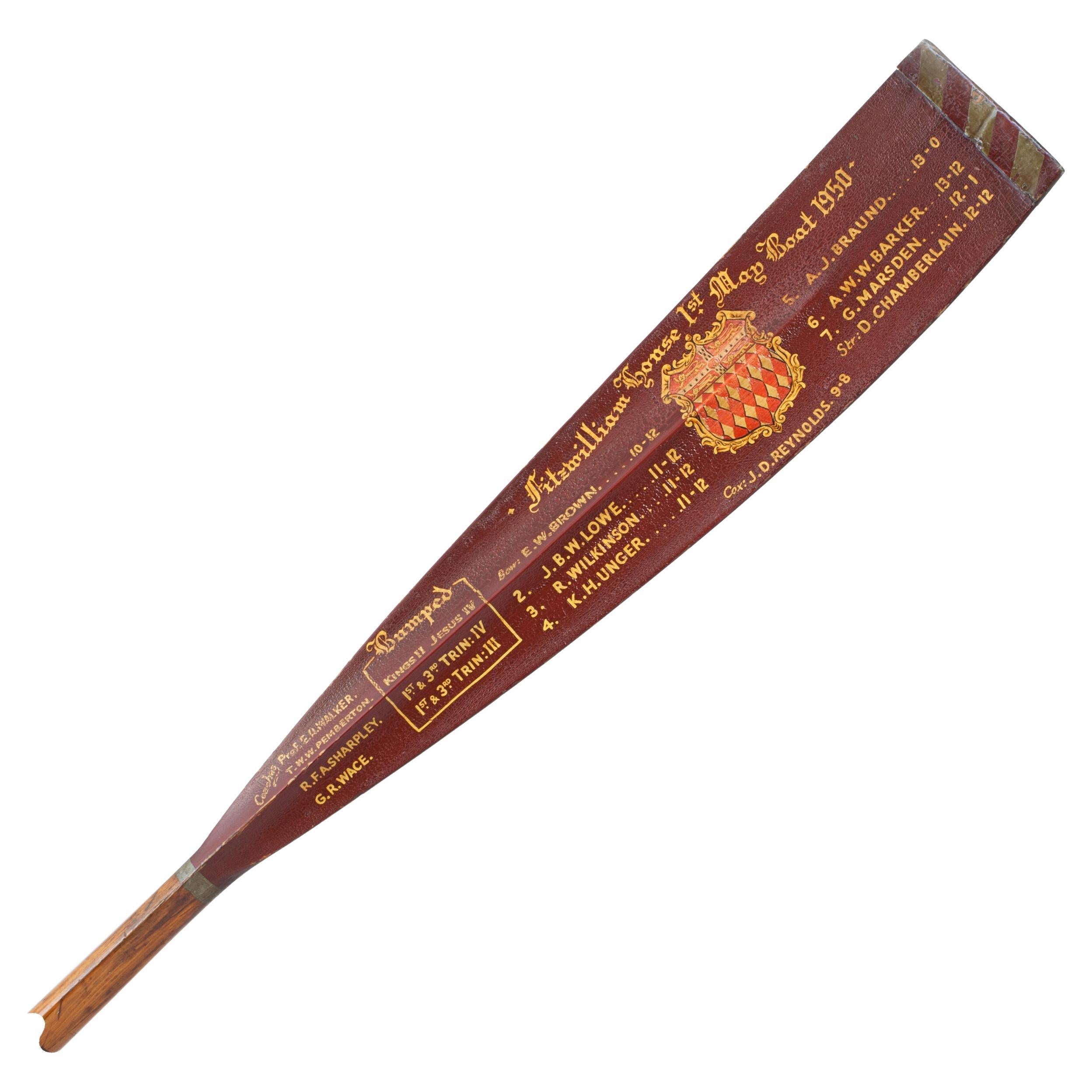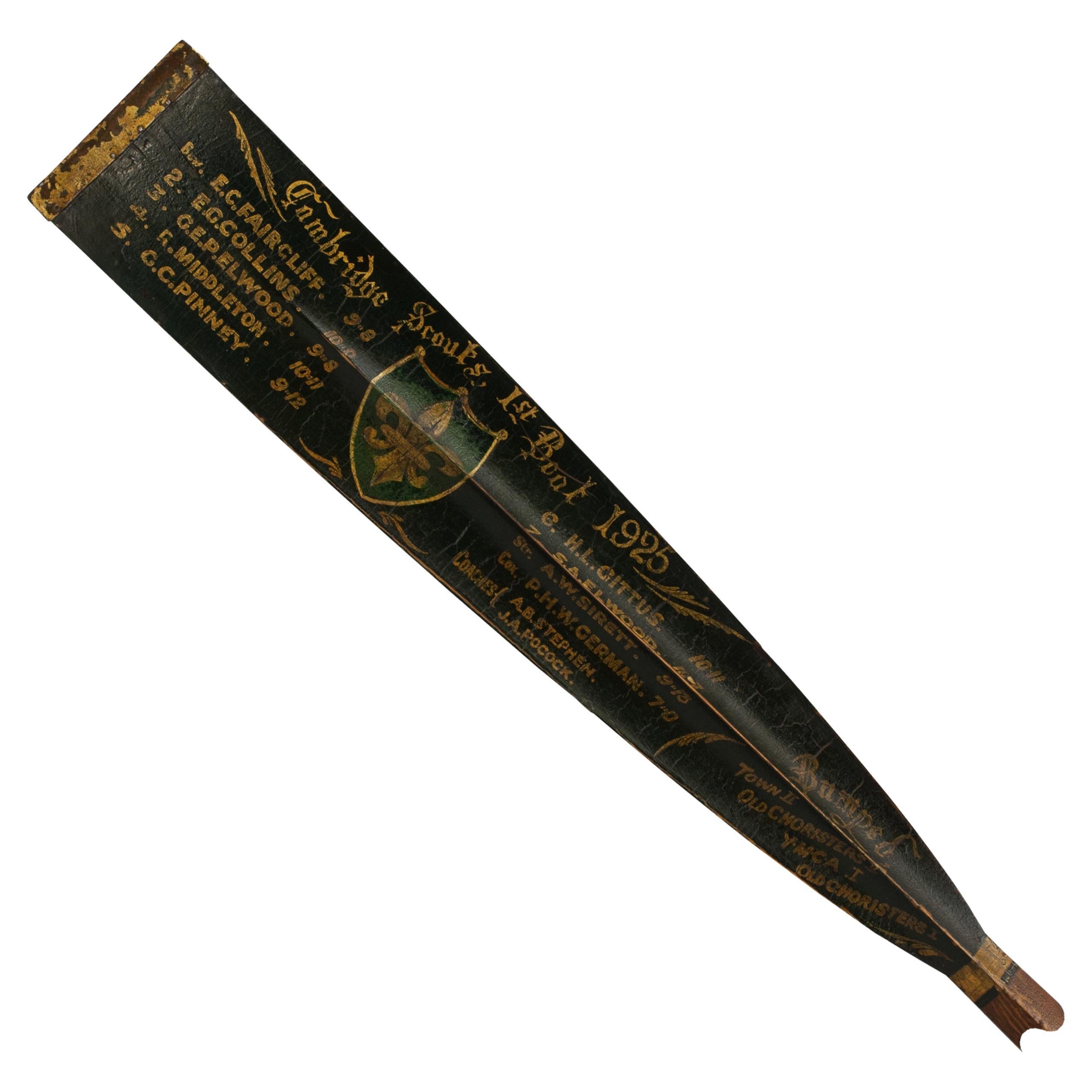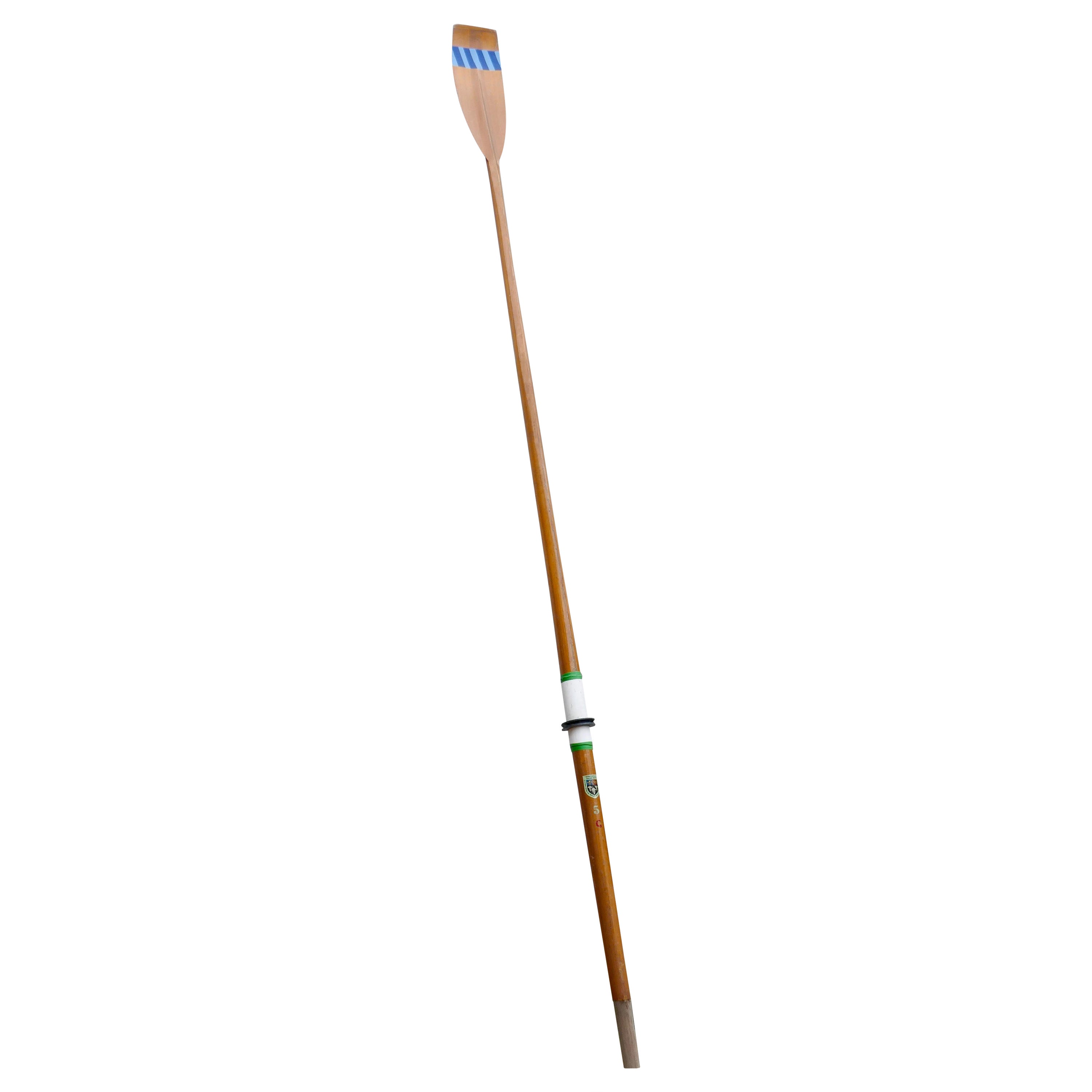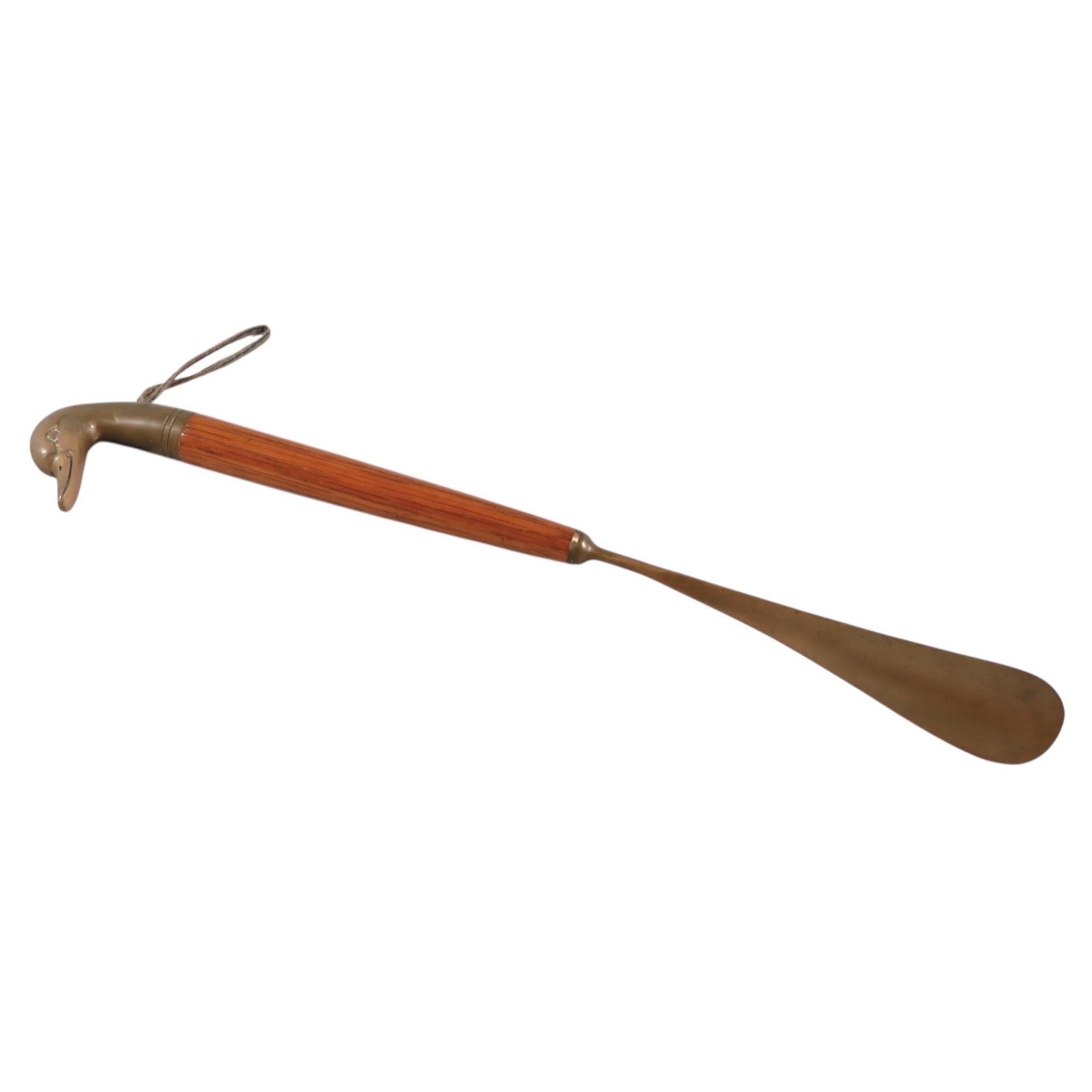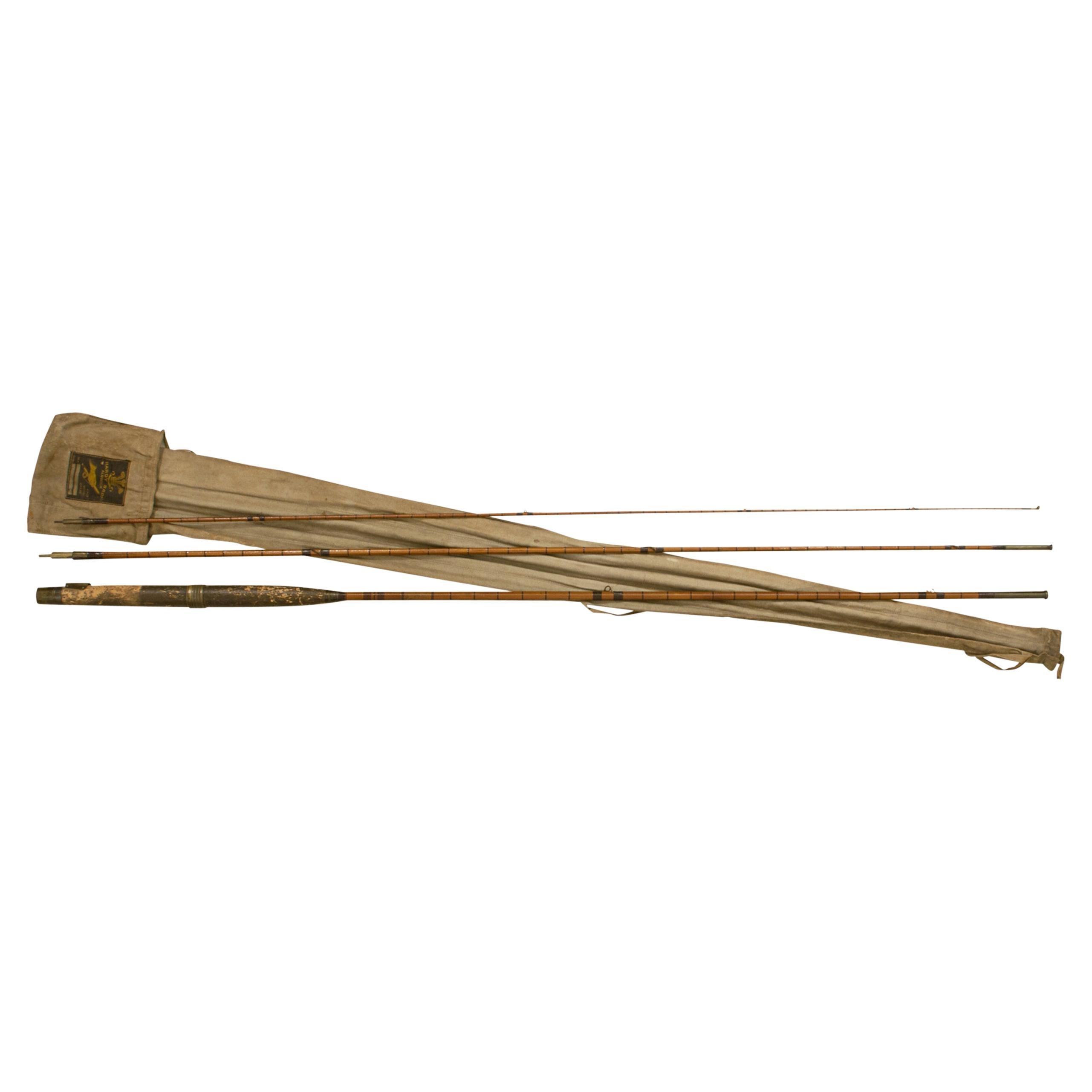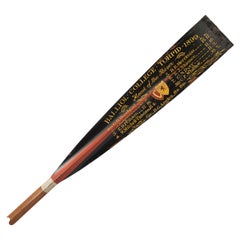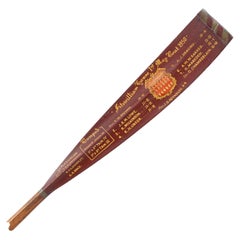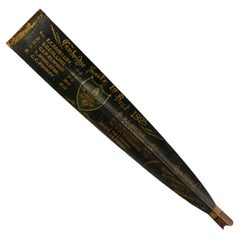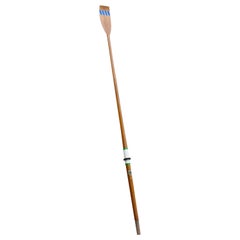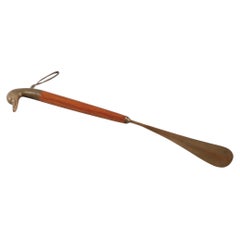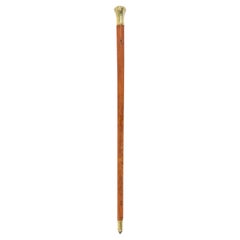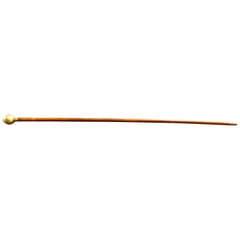Items Similar to 12' Presentation Rowing Oar Trophy, Oxford University, 1897 Balliol
Want more images or videos?
Request additional images or videos from the seller
1 of 18
12' Presentation Rowing Oar Trophy, Oxford University, 1897 Balliol
$3,014.37
£2,200
€2,566.18
CA$4,128.93
A$4,592.27
CHF 2,397.94
MX$55,883.04
NOK 30,625.36
SEK 28,721.19
DKK 19,152.40
Shipping
Retrieving quote...The 1stDibs Promise:
Authenticity Guarantee,
Money-Back Guarantee,
24-Hour Cancellation
About the Item
Antique Rowing Oar, 1897 Balliol College Oxford, 2nd Torpid.
The full-length oar is an original traditional presentation rowing oar with gilt calligraphy and Balliol college insignias. It is a beautiful oar and in original condition. The calligraphy denotes the crew's names and weights with the oar being No.7 denoting it belonged to W. Mitchell - Thomson. Most probably William Lowson Mitchell-Thomson, 1st Baron Selsdon KBE PC (15 April 1877 - 24 December 1938), known as Sir William Mitchell-Thomson, 2nd Baronet. We also have two other oars once belonging to Mitchell - Thomson, Head of the River - Torpid 1899 & Head of the River - Torpid 1898.
The calligraphy on this blade reads:-
Balliol College 2nd Torpid 1897
Six Bumps - Wadham - Oriel - Jesus - CH CH II - Keble - Pembroke
Bow G.H. Moorhead 9st. 13lbs
2. M. Irving 10.9¼
3. E.H. Pelham 11.7
4. E.J. Skinner 11.8
5. H.W. Hallifax 12.7
6. C.U. Wills 11.5½
7. W. Mitchell - Thomson 12.2
Str. J.L. Coolidge 10.13
Cox. ???????araj Singh 8st.10lbs
As the oar is full length (12 foot) shipping can be quite expensive. We have come up with an ingenious way to cut the oar so as to make shipping cheaper, the oar can then be easily reassembled. One of the images shows different images of an oar that has been cut down. It is cut by the leather sleeve so the joint is less visible or obvious. The oar can then be bolted together to make the oar one solid piece.
Please do enquire about the different shipping options.
Any crew which records four consecutive bumps is said to have 'gained their oars'. The prize being a full-size oar decorated with the names of the full crew in gold lettering on the college colours for each rower. The cox is given a decorated rudder and the coach receives a decorated wooden shield with a mock-up of the bow end of a boat.
Both Oxford and Cambridge Universities host two university bumps races yearly, each lasting several days. The races are for eights (i.e. eight rowers and a cox), each representing one of the university's various colleges. One of the races is held in early spring and the other in early summer, in Oxford they are called 'Torpids' in the spring and 'Eights' in the summer, in Cambridge these are called 'Lent Bumps' and 'May Bumps'. The leading crews of the Lent Bumps go on to race the leading Oxford Torpids crews at the Henley Boat Races around Easter.
The first attested bumps race took place in Oxford in 1815 and was between two eights from Brasenose College and Jesus College. Twelve years later Lent Bumps racing commenced at Cambridge University. As the Isis and Cam are long narrow rivers, not ideal for normal side by side racing, Bumps racing evolved. The competing crews line up bow-to-stern in order, one behind the other with gaps of about 1½ boat lengths between them. The start of the race commences with the firing of a cannon, the idea to progress up their division by attempting to catch and Bump (touch) the boat in front whilst simultaneously trying not to be Bumped by the boat behind. The ultimate aim becoming top of the first division and "Head Of The River". When a bump has taken place both of the crews involved in the Bump pull over to the river bank and take no further part in that race, allowing the rest of the division to pass. The only difference is in Torpids where the crew whose boat was Bumped has to continue racing (and is liable to be bumped again). It is possible to "over bump", if the 2 crews involved in the Bump have pulled over and the crew behind them manage to catch the boat that was in front of them, this is an "over bump".
William Lowson Mitchell-Thomson, 1st Baron Selsdon KBE PC (15 April 1877 - 24 December 1938) was a Scottish politician who served as British Postmaster-General from 1924-1929, during which time the BBC came into existence as a Corporation. He chaired the Television Committee of 1934-5 and its successor Television Advisory Committee (1935-1940) until his death in 1938.
Early life
Mitchell-Thomson was born at 7 Carlton Terrace, Edinburgh, the son of Mitchell Mitchell-Thomson, Lord Provost of Edinburgh (1897-1900), who was created a baronet in 1900.
He was educated at Winchester College and Balliol College, Oxford. He earned his LL.B with distinction from the University of Edinburgh in 1902 and joined the Scottish bar that same year, but spent several years travelling. He was engaged for a time in West India business. He travelled extensively in many parts of the world, including Siberia, Manchuria, and Korea, before returning to Scotland.
Political career
He was elected as a Unionist Member of Parliament for North West Lanarkshire in 1906, becoming prominent among the young Unionists and proving himself as an astute examiner at question time while in the Opposition, serving until his defeat at the January 1910 general election.
Described once as "the best looking man in the House of Commons", he had black, wavy hair, and was clean shaven, with a prominent chin and bold forehead. According to one writer, he was a favourite choice as a platform speaker for his party when it was known that women electors would predominate among the audience.
He was an Irish Unionist Party MP for North Down from April 1910 until 1918.
During the First World War he held the rank of Hon. Lieutenant in the Royal Naval Volunteer Reserve. He served as Director of Restriction of Enemy Supplies. He was appointed a Commander of the Order of the British Empire in the 1918 New Year Honours.
Following the War, he was appointed the British representative on the Supreme Economic Council followed by appointments as Parliamentary Secretary to the Ministry of Food and at the Board of Trade.
He was then MP for Glasgow Maryhill between 1918 and 1922, then Conservative MP for Croydon South, South London from 1923 to 1932.
Thus, he had the distinction of representing, in turn, Scottish, Irish, and English constituencies.
Postmaster General
In 1922, Mitchell-Thomson was Parliamentary Secretary to the Board of Trade.
As Postmaster-General from 1924 until 1929, he proved an energetic and capable minister. Postal reforms were instituted, and the telephone service was materially improved, extended, and modernised. He came in for criticism, however, by refusing on a number of occasions to receive deputations.
During the General Strike in May 1926 be held the position of Chief Civil Commissioner. His part, as he himself afterwards described it, was "to organise the machine to secure that the will of the majority of the people should prevail".
Having played such an important part in the development of the BBC, Mitchell-Thompson's name was subsequently mentioned twice in connection with key posts at the BBC. The first occasion was as successor to Viscount Bridgeman, who died in 1935 while Chairman of the Board of Governors. He was also considered a likely candidate for the position of Director- General vacated by Sir John Reith in June 1938.
Peerage and honours
In 1932, he resigned from the House of Commons and was raised to the peerage, taking the title of his last constituency, Baron Selsdon of Croydon in the county of Surrey.
He was also KBE, CBE, a member of the legion of Honour, a recipient of the Order of the Crown of Italy, and a member of His Majesty's Bodyguard in Scotland, Royal Company of Archers.
Television Advisory Committees
He was Chairman of the Television Advisory Committee which was formed in 1934 and reported in January 1935.
Personal life
In 1909 he married Madeleine, the daughter of the late Sir Malcolm McEacharn, of Galloway House, Garlieston, Wigtownshire, and his heir, the Hon. Patrick Mitchell-Thomson, was born in 1913. The Hon. Patrick married in 1936 Phoebette, daughter of Mr Crossley Swithinbank, of Donnington Grove, Newbury.
Lord Selsdon's first marriage was dissolved in 1932, and in 1933 he married Effie Lilian Loder Johnson, daughter of Lieutenant-Colonel Charles Brennan, of Mullingar, Ireland, who, as Miss Effie Cook, was once a member of Pellissier's 'Follies'.
Death
William Mitchell-Thompson became suddenly ill on Christmas Eve and died the same night. He was aged 61. At his bedside was his only son, the Hon Patrick Mitchell-Thomson.
Taken from Scotland On Air
Dimensions:
Height
366 cm / 144 "
Width
15 cm / 6"
Depth
9 cm / 3 "
- Dimensions:Height: 144.1 in (366 cm)Width: 5.91 in (15 cm)Depth: 3.55 in (9 cm)
- Style:Sporting Art (Of the Period)
- Materials and Techniques:
- Place of Origin:
- Period:
- Date of Manufacture:1897
- Condition:Wear consistent with age and use. Calligraphy is a little faded, the blade tip with historical cracks and repair, handle end has been cut down a fraction.
- Seller Location:Oxfordshire, GB
- Reference Number:Seller: 303021stDibs: LU975741831542
About the Seller
5.0
Platinum Seller
Premium sellers with a 4.7+ rating and 24-hour response times
Established in 1977
1stDibs seller since 2013
788 sales on 1stDibs
Typical response time: 2 hours
Associations
LAPADA - The Association of Arts & Antiques Dealers
- ShippingRetrieving quote...Shipping from: Oxfordshire, United Kingdom
- Return Policy
Authenticity Guarantee
In the unlikely event there’s an issue with an item’s authenticity, contact us within 1 year for a full refund. DetailsMoney-Back Guarantee
If your item is not as described, is damaged in transit, or does not arrive, contact us within 7 days for a full refund. Details24-Hour Cancellation
You have a 24-hour grace period in which to reconsider your purchase, with no questions asked.Vetted Professional Sellers
Our world-class sellers must adhere to strict standards for service and quality, maintaining the integrity of our listings.Price-Match Guarantee
If you find that a seller listed the same item for a lower price elsewhere, we’ll match it.Trusted Global Delivery
Our best-in-class carrier network provides specialized shipping options worldwide, including custom delivery.More From This Seller
View All12' Presentation Rowing Oar Trophy, Oxford University, 1899 Balliol College
Located in Oxfordshire, GB
Antique Rowing Oar, 1899 Balliol College Oxford, Head of the River.
The full-length oar is an original traditional presentation rowing oar with gilt calligraphy and Balliol college insignias. The rowing blade...
Category
Antique 19th Century British Sports Equipment and Memorabilia
Materials
Pine
Presentation Rowing Oar Trophy, Fitzwilliam House, 1st May Boat 1950
Located in Oxfordshire, GB
Antique Rowing Oar, 1950 Fitzwilliam House, May Boat.
The full-length oar is an original traditional Cambridge University presentation rowing oar with g...
Category
20th Century British Sporting Art Sports Equipment and Memorabilia
Materials
Pine, Paint
Antique Cambridge Scouts Rowing Oar, 1925
Located in Oxfordshire, GB
Cambridge Scouts 1st Boat Presentation Rowing Oar.
The full-length oar is an original traditional presentation rowing oar with gilt calligraphy, the crew's names and weights and the Scouts emblem. The Cambridge Scout Boat Club was formed in 1923 and was successful from the start, they were Head of the River on three occasions.
The blade reads:-
Cambridge Scouts 1st Boat 1925.
Bow. E.C. Faircliff, 9.8.
2. E.G. Collins. 10.0.
3. G.E.P. Elwood. 9.8.
4. R. Middleton. 10.11.
5. G.C. Pinney. 9.12.
6. H.L. Gittus. 10.11.
7. S.A. Elwood. 10.7.
Str. A.W. Sirett. 9.13.
Cox. P.H.W. German. 7.0.
Coaches A.B. Stephen, J.A. Pocock.
Bumped:- Town II, Old Choristers II, Y.M.C.A I, Old Choristers I.
IMPORTANT NOTICE REGARDING SHIPPING.
As the oar is full length (12 foot) shipping can be quite expensive. We have come up with an ingenious way to cut the oar so as to make shipping cheaper, the oar can then be easily reassembled. One of the images shows different images of an oar that has been cut down. It is cut by the leather sleeve so the joint is less visible or obvious. The oar can then be bolted together to make the oar one solid piece.
Please do enquire about the different shipping options.
The Cambridge Scout Boat Club was formed in 1923 on CC Charlie Wood's advice. It was thought to be the only such club in the country. C T Wood had rowed at Shrewsbury School and was treasurer for '99 rowing club in its early days.
'There are three particular things we owe to C.T.Wood;… in 1923 he urged the formation of the Scout Boat Club, of which Fred Feary was the first Captain, and I a humble non-rowing member'. WTT Archaeology 1978
The club was for Scout Masters, Scouts and Rovers over 16.
The club was successful from the start and the first boat sat in the top three for a quarter of time it raced and the top five for half the time. Scouts I reached 3rd position by the end of their fourth years racing and was only out if the top 5 for one year in the next quarter of a century.
In some years it put out four boats in the town bumps and four in the Time Race, the only two events for which we have most of the results It was Head of the River on three occasions.
Scouts I had the rare distinction of starting from last boat and reaching Head of the River in the town bumps without being bumped.
The Scouts' Debut
'In 1923 a new club, known as the Cambridge Scouts Boat Club, was formed. It became affiliated with the Cambridge Rowing...
Category
Early 20th Century British Sporting Art Sports Equipment and Memorabilia
Materials
Pine
Split Cane, Hardy Fly Fishing Rod
By Hardy Bros.
Located in Oxfordshire, GB
Hardy Bros. Split Cane Palakona Fly Rod.
An Edwardian three piece split cane fly rod in original condition with Hardy's canvas bag. The 10'6" fly rod with 'Lockfast' joints, cork han...
Category
Early 20th Century English Sports Equipment and Memorabilia
Materials
Bamboo
Hardy Perfection Fishing Rod
Located in Oxfordshire, GB
The "Perfection" 9ft Hardy Palakona Fishing Rod.
A beautifully 2 piece 9' split cane fly fishing rod by Hardy of Alnwick. The rod is in very good condition with the registration numb...
Category
Late 20th Century British Sports Equipment and Memorabilia
Materials
Bamboo
Hardy Gold Medal 9 foot trout Fly Fishing Rod
Located in Oxfordshire, GB
Vintage Hardy Split Cane 'Palakona' 9' Fly Fishing Rod.
The Hardy 'Gold Medal' rod is a split cane Palakona 2-piece trout fly rod with spare tip made by Hardy's of Alnwick. This rod ...
Category
Mid-20th Century British Sports Equipment and Memorabilia
Materials
Bamboo
You May Also Like
Very Long Racing Scull or Oar from Eton College Windsor
Located in Godshill, Isle of Wight
Very Long Racing Scull or Oar from Eton College Windsor
This is a fine quality extra long oar from Eton College, the spoon or blade has blue chevrons ...
Category
Early 20th Century Folk Art Nautical Objects
Materials
Ash
Brass and Wood Duck Shoehorn
Located in Bradenton, FL
A brass and wood shoehorn. The handle is made of brass cast in the shape of a duck’s head, with an attached string for ease of storage. The round wooden stem finishes in a traditiona...
Category
Mid-20th Century Bohemian Hat Racks and Stands
Materials
Brass
English Victorian Wood and Brass Cane
Located in Queens, NY
19th Century English Victorian wood cane with etched brass top.
Category
Antique Late 19th Century British Victorian Sports Equipment and Memorab...
Materials
Brass
The Stick has CANFORD SCHOOL O.T.C. Crest on the Round Head
Located in Godshill, Isle of Wight
CANFORD SCHOOL O.T.C. swagger stick.
The stick has CANFORD SCHOOL O.T.C. crest on the round head
The metal top appears to be a white metal overprinted to look like brass
The sti...
Category
Mid-20th Century British Colonial Sports Equipment and Memorabilia
Materials
Cane
English Victorian Wood and Brass Cane
Located in Queens, NY
English Victorian light wood cane with brass ball top and fluted sleeve.
Category
Antique Late 19th Century Victorian Sports Equipment and Memorabilia
Materials
Brass
English Victorian Cane with Brass Flame
Located in Queens, NY
English Victorian light oak walking cane with bronze flame form handle and brass tip.
Category
Antique Late 19th Century British Victorian Sports Equipment and Memorab...
Materials
Brass, Bronze
